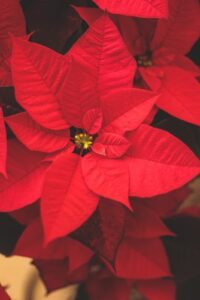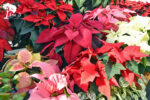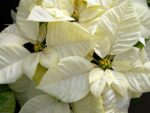
Have you decorated for Christmas? Besides the Christmas tree, the mantel, and hanging the stockings with care, flowers can add the perfect finishing touch for your holiday celebration, especially poinsettias. I remember when there were red and white ones and that was about it for the color choices. Now there are more than 100 varieties that range in color from pink, to burgundy, purple, peach, and yellow, to name a few. Some have splashes of color on the bracts. Some have variegated leaves. There are also double varieties. But, by far, the most common and most popular is traditional red.
I usually wait and buy my poinsettias around the end of the first week of December, just so they hang in and look their best from Christmas in to the new year. I use to nurture them until the spring so that I could add them to a baker’s rack I keep on my patio. I have never had any luck with getting them to rebloom the following year, possibly because it takes the patience of Job. Have you ever tried to make a poinsettia bloom again? Any luck?
Caring for your poinsettia
- Provide lots of sunlight — a sunny window with east, west, or southern exposure is best. Also try to keep the temperature between 65 and 70 degrees during the day, keeping in mind that the area around a drafty window can be quite a bit cooler than the rest of the room. If your plant’s leaves are touching a cold window, they may drop off. At night, poinsettias like a slightly lower temperature (55 – 60 degrees), but avoid drastic drops in temperatures.
- Make sure to water the poinsettia whenever the surface of the soil feels dry. Give the plant a good watering, but don’t flood or soak it — gravel in the bottom of the pot will help keep the roots dry.
- To coax your plant back into bloom, let it dry out gradually starting in April. Water just enough to keep the stem from shriveling, and put the plant in a spot that stays about 60 degrees.In mid-May, prune the stems to 4 inches high and repot the poinsettia in a slightly larger pot. Move it to a warm location with good light and resume watering. When new growth emerges, fertilize every two weeks with a complete fertilizer. In July, pinch back the stems. Pinch again in mid-August. Poinsettias need 10 weeks of 12 hours or less of sunlight each day to show color. For Christmas flowers, keep the plant in complete darkness from 5 p.m. to 8 a.m. daily, starting around Oct. 1.
- Poinsettias are part of the Euphorbiaceae or Spurge family. Botanically, the plant is known as Euphorbia pulcherrima.
- Poinsettias are not poisonous. Many plants in the Euphorbiaceae family ooze a milky sap. Some people with latex allergies have had a skin reaction (most likely to the sap) after touching the leaves. For pets, the poinsettia sap may cause mild irritation or nausea. Probably best to keep pets away from the plant, especially puppies and kittens.
- The showy colored parts of poinsettias that most people think of as the flowers are actually colored bracts (modified leaves).
- Joel Roberts Poinsett introduced the poinsettia plant to the United States from Mexico. Poinsett was a botanist, physician and the first United States Ambassador to Mexico.
- December 12th is Poinsettia Day, which marks the death of Joel Roberts Poinsett in 1851.
- In Mexico the poinsettia is a perennial shrub that will grow 10-15 feet tall.
- Poinsettias contribute over $250 million to the U.S. economy at the retail level.
 I’ll leave you with the Legend of the Poinsettia. This touching story is a reminder that in this season, “Even the most humble gift, if given in love, will be acceptable in His eyes.”
I’ll leave you with the Legend of the Poinsettia. This touching story is a reminder that in this season, “Even the most humble gift, if given in love, will be acceptable in His eyes.”
Pepita, a poor Mexican girl who had no gift to present the Christ Child at Christmas Eve Services. As Pepita walked slowly to the chapel with her cousin Pedro, her heart was filled with sadness rather than joy. I am sure, Pepita, that even the most humble gift, if given in love, will be acceptable in His eyes,” said Pedro consolingly.
Not knowing what else to do, Pepita knelt by the roadside and gathered a handful of common weeds, fashioning them into a small bouquet. Looking at the scraggly bunch of weeds, she felt more saddened and embarrassed than ever by the humbleness of her offering. She fought back a tear as she entered the small village chapel.
As she approached the altar, she remembered Pedro’s kind words: “Even the most humble gift, if given in love, will be acceptable in His eyes.” She felt her spirit lift as she knelt to lay the bouquet at the foot of the nativity scene. Suddenly, the bouquet of weeds burst into blooms of brilliant red, and all who saw them were certain that they had witnessed a Christmas miracle right before their eyes.
From that day on, the bright red flowers were known as the Flores de Noche Buena, or Flowers of the Holy Night, for they bloomed each year during the Christmas season and thus, the legend of the poinsettia was born.






